Essential Differences and Similarities in Teen and Adult Violence
VerifiedAdded on 2022/10/10
|22
|2819
|281
AI Summary
This document discusses the essential differences and similarities in teen and adult violence, and how early life experiences with domestic violence can set patterns and expectations that could lead to a greater likelihood of entering abusive relationships in adulthood. It also includes a safety plan for those experiencing domestic violence. The subject, course code, course name, and college/university are not mentioned.
Contribute Materials
Your contribution can guide someone’s learning journey. Share your
documents today.
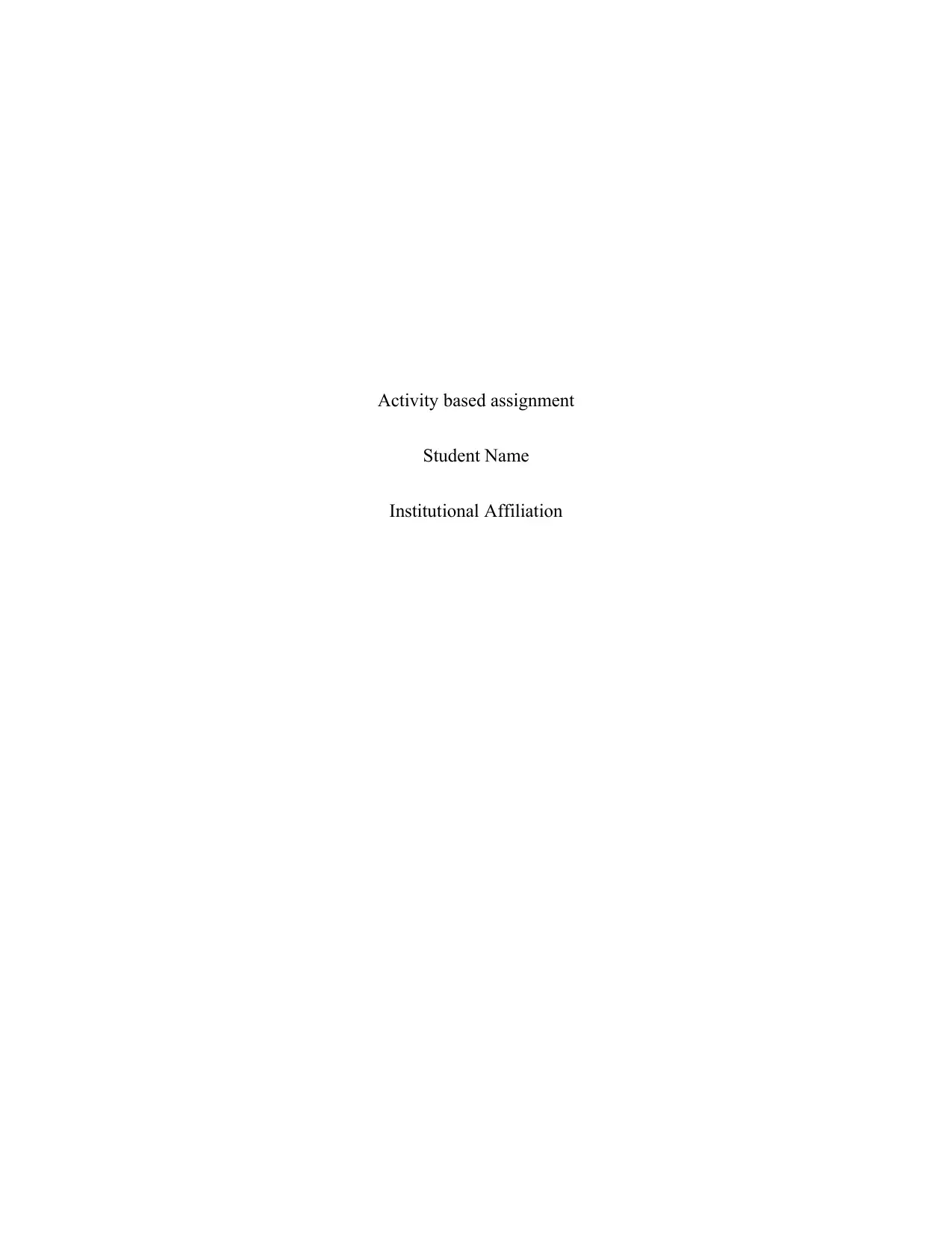
Activity based assignment
Student Name
Institutional Affiliation
Student Name
Institutional Affiliation
Secure Best Marks with AI Grader
Need help grading? Try our AI Grader for instant feedback on your assignments.
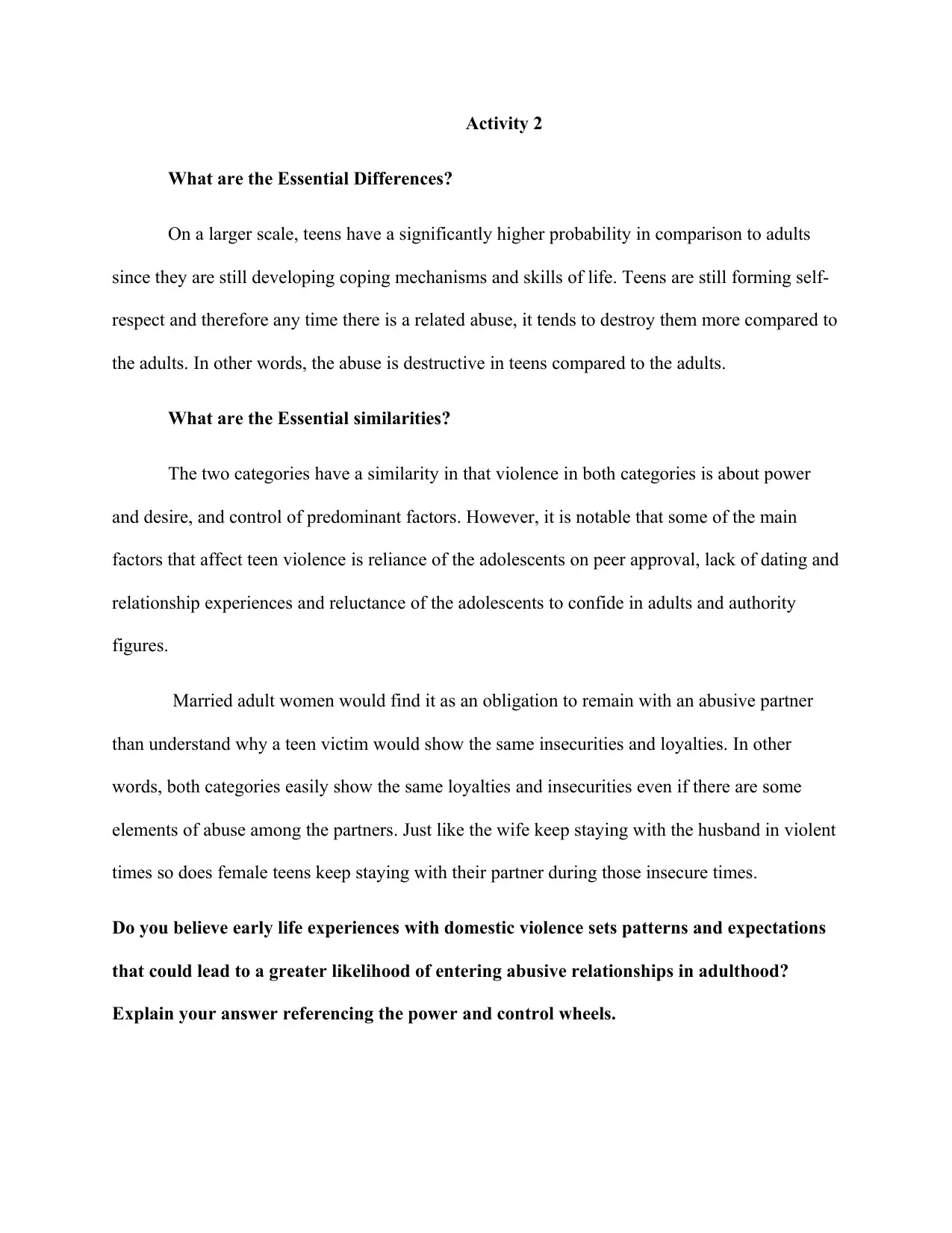
Activity 2
What are the Essential Differences?
On a larger scale, teens have a significantly higher probability in comparison to adults
since they are still developing coping mechanisms and skills of life. Teens are still forming self-
respect and therefore any time there is a related abuse, it tends to destroy them more compared to
the adults. In other words, the abuse is destructive in teens compared to the adults.
What are the Essential similarities?
The two categories have a similarity in that violence in both categories is about power
and desire, and control of predominant factors. However, it is notable that some of the main
factors that affect teen violence is reliance of the adolescents on peer approval, lack of dating and
relationship experiences and reluctance of the adolescents to confide in adults and authority
figures.
Married adult women would find it as an obligation to remain with an abusive partner
than understand why a teen victim would show the same insecurities and loyalties. In other
words, both categories easily show the same loyalties and insecurities even if there are some
elements of abuse among the partners. Just like the wife keep staying with the husband in violent
times so does female teens keep staying with their partner during those insecure times.
Do you believe early life experiences with domestic violence sets patterns and expectations
that could lead to a greater likelihood of entering abusive relationships in adulthood?
Explain your answer referencing the power and control wheels.
What are the Essential Differences?
On a larger scale, teens have a significantly higher probability in comparison to adults
since they are still developing coping mechanisms and skills of life. Teens are still forming self-
respect and therefore any time there is a related abuse, it tends to destroy them more compared to
the adults. In other words, the abuse is destructive in teens compared to the adults.
What are the Essential similarities?
The two categories have a similarity in that violence in both categories is about power
and desire, and control of predominant factors. However, it is notable that some of the main
factors that affect teen violence is reliance of the adolescents on peer approval, lack of dating and
relationship experiences and reluctance of the adolescents to confide in adults and authority
figures.
Married adult women would find it as an obligation to remain with an abusive partner
than understand why a teen victim would show the same insecurities and loyalties. In other
words, both categories easily show the same loyalties and insecurities even if there are some
elements of abuse among the partners. Just like the wife keep staying with the husband in violent
times so does female teens keep staying with their partner during those insecure times.
Do you believe early life experiences with domestic violence sets patterns and expectations
that could lead to a greater likelihood of entering abusive relationships in adulthood?
Explain your answer referencing the power and control wheels.
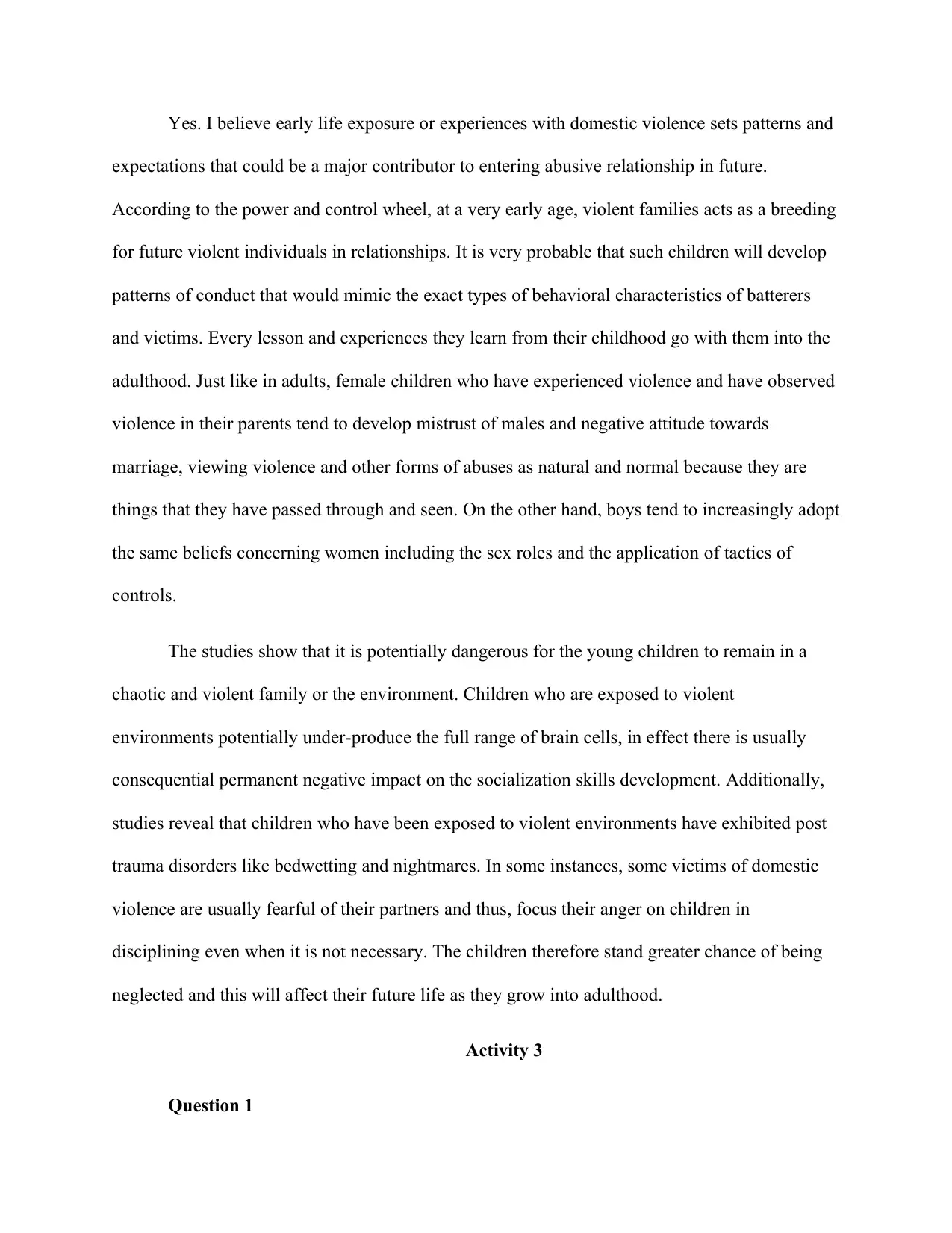
Yes. I believe early life exposure or experiences with domestic violence sets patterns and
expectations that could be a major contributor to entering abusive relationship in future.
According to the power and control wheel, at a very early age, violent families acts as a breeding
for future violent individuals in relationships. It is very probable that such children will develop
patterns of conduct that would mimic the exact types of behavioral characteristics of batterers
and victims. Every lesson and experiences they learn from their childhood go with them into the
adulthood. Just like in adults, female children who have experienced violence and have observed
violence in their parents tend to develop mistrust of males and negative attitude towards
marriage, viewing violence and other forms of abuses as natural and normal because they are
things that they have passed through and seen. On the other hand, boys tend to increasingly adopt
the same beliefs concerning women including the sex roles and the application of tactics of
controls.
The studies show that it is potentially dangerous for the young children to remain in a
chaotic and violent family or the environment. Children who are exposed to violent
environments potentially under-produce the full range of brain cells, in effect there is usually
consequential permanent negative impact on the socialization skills development. Additionally,
studies reveal that children who have been exposed to violent environments have exhibited post
trauma disorders like bedwetting and nightmares. In some instances, some victims of domestic
violence are usually fearful of their partners and thus, focus their anger on children in
disciplining even when it is not necessary. The children therefore stand greater chance of being
neglected and this will affect their future life as they grow into adulthood.
Activity 3
Question 1
expectations that could be a major contributor to entering abusive relationship in future.
According to the power and control wheel, at a very early age, violent families acts as a breeding
for future violent individuals in relationships. It is very probable that such children will develop
patterns of conduct that would mimic the exact types of behavioral characteristics of batterers
and victims. Every lesson and experiences they learn from their childhood go with them into the
adulthood. Just like in adults, female children who have experienced violence and have observed
violence in their parents tend to develop mistrust of males and negative attitude towards
marriage, viewing violence and other forms of abuses as natural and normal because they are
things that they have passed through and seen. On the other hand, boys tend to increasingly adopt
the same beliefs concerning women including the sex roles and the application of tactics of
controls.
The studies show that it is potentially dangerous for the young children to remain in a
chaotic and violent family or the environment. Children who are exposed to violent
environments potentially under-produce the full range of brain cells, in effect there is usually
consequential permanent negative impact on the socialization skills development. Additionally,
studies reveal that children who have been exposed to violent environments have exhibited post
trauma disorders like bedwetting and nightmares. In some instances, some victims of domestic
violence are usually fearful of their partners and thus, focus their anger on children in
disciplining even when it is not necessary. The children therefore stand greater chance of being
neglected and this will affect their future life as they grow into adulthood.
Activity 3
Question 1
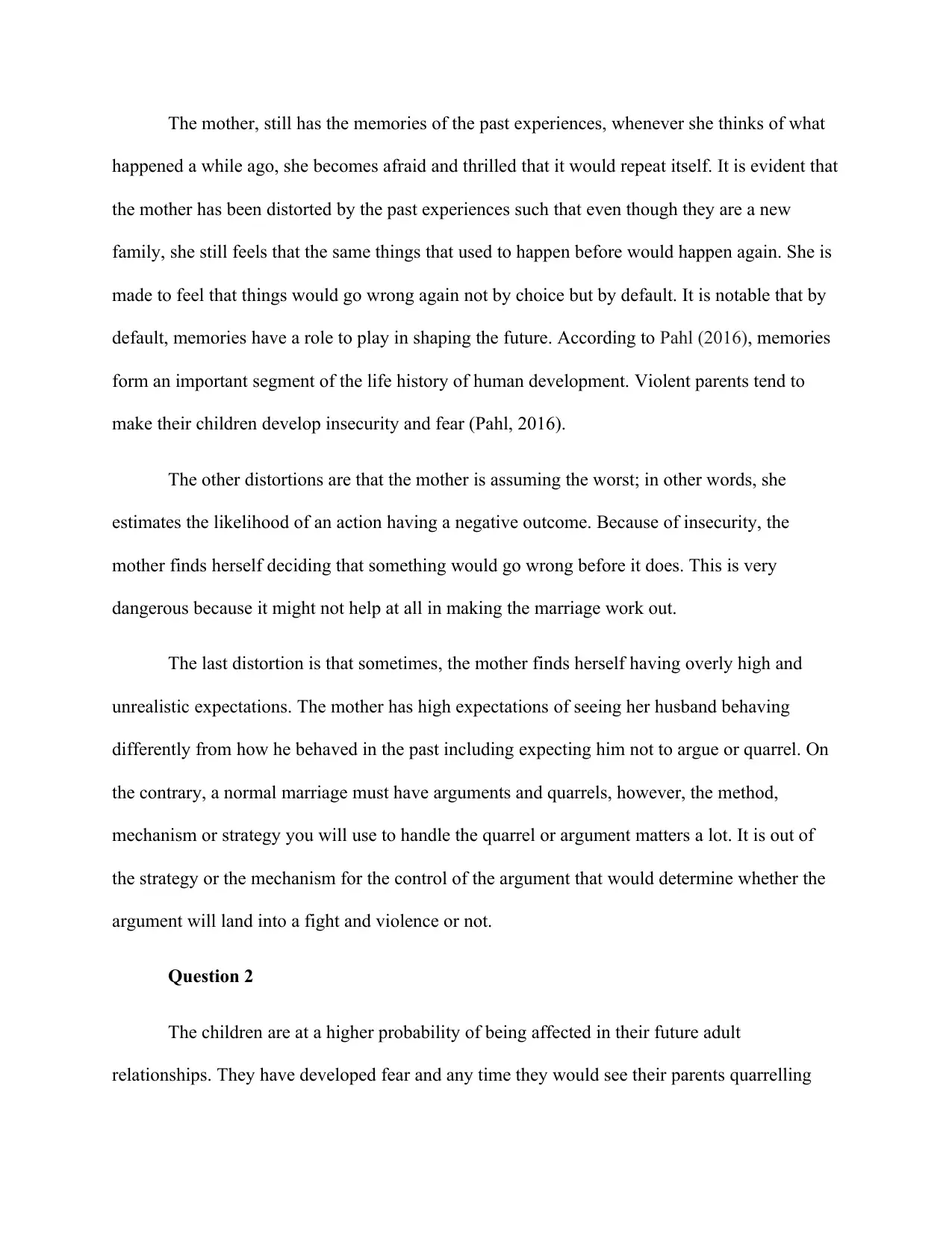
The mother, still has the memories of the past experiences, whenever she thinks of what
happened a while ago, she becomes afraid and thrilled that it would repeat itself. It is evident that
the mother has been distorted by the past experiences such that even though they are a new
family, she still feels that the same things that used to happen before would happen again. She is
made to feel that things would go wrong again not by choice but by default. It is notable that by
default, memories have a role to play in shaping the future. According to Pahl (2016), memories
form an important segment of the life history of human development. Violent parents tend to
make their children develop insecurity and fear (Pahl, 2016).
The other distortions are that the mother is assuming the worst; in other words, she
estimates the likelihood of an action having a negative outcome. Because of insecurity, the
mother finds herself deciding that something would go wrong before it does. This is very
dangerous because it might not help at all in making the marriage work out.
The last distortion is that sometimes, the mother finds herself having overly high and
unrealistic expectations. The mother has high expectations of seeing her husband behaving
differently from how he behaved in the past including expecting him not to argue or quarrel. On
the contrary, a normal marriage must have arguments and quarrels, however, the method,
mechanism or strategy you will use to handle the quarrel or argument matters a lot. It is out of
the strategy or the mechanism for the control of the argument that would determine whether the
argument will land into a fight and violence or not.
Question 2
The children are at a higher probability of being affected in their future adult
relationships. They have developed fear and any time they would see their parents quarrelling
happened a while ago, she becomes afraid and thrilled that it would repeat itself. It is evident that
the mother has been distorted by the past experiences such that even though they are a new
family, she still feels that the same things that used to happen before would happen again. She is
made to feel that things would go wrong again not by choice but by default. It is notable that by
default, memories have a role to play in shaping the future. According to Pahl (2016), memories
form an important segment of the life history of human development. Violent parents tend to
make their children develop insecurity and fear (Pahl, 2016).
The other distortions are that the mother is assuming the worst; in other words, she
estimates the likelihood of an action having a negative outcome. Because of insecurity, the
mother finds herself deciding that something would go wrong before it does. This is very
dangerous because it might not help at all in making the marriage work out.
The last distortion is that sometimes, the mother finds herself having overly high and
unrealistic expectations. The mother has high expectations of seeing her husband behaving
differently from how he behaved in the past including expecting him not to argue or quarrel. On
the contrary, a normal marriage must have arguments and quarrels, however, the method,
mechanism or strategy you will use to handle the quarrel or argument matters a lot. It is out of
the strategy or the mechanism for the control of the argument that would determine whether the
argument will land into a fight and violence or not.
Question 2
The children are at a higher probability of being affected in their future adult
relationships. They have developed fear and any time they would see their parents quarrelling
Secure Best Marks with AI Grader
Need help grading? Try our AI Grader for instant feedback on your assignments.

they would hold their breath. It is a concern that in future they would hardly have trust in male
figures if they are females and female figures if they are males. In fact, they will fear marriage
and it is highly likely that it will take them a lot of time and efforts to decide whether they should
carry on because of what they had consistently observed occur in their own family- the people
they trusted (Johnson, 2016).
Question 3
I would advice the mother to have a positive mind and eliminate the negative cognitive
distortions for example expecting that something bad will happen. According to Erten and
Keskin (2018) when you expect something bad to happen, it will obviously happen because we
do not get what we want in life but what we expect, staying positive about her marriage always
should be her slogan and daily bread. While it is acknowledgeable that past experiences are not
easily forgettable, it is important that she keeps hoping for the best. Hoping for the best starts
marking the journey to redressing the love-life of a marriage and cover up all the filthy rugged
spoilt phases of life that were once lived irrationally. Is doing so as a couple, they will help a big
deal in shaping the children and making them gain their confidence in them. If they shape their
life and make out their marriage work out in the best way possible then the children distressed
mind and negative attitude towards marriage would vanish over time.
Activity 4
Pat 1
Filled the form
Part 2
figures if they are females and female figures if they are males. In fact, they will fear marriage
and it is highly likely that it will take them a lot of time and efforts to decide whether they should
carry on because of what they had consistently observed occur in their own family- the people
they trusted (Johnson, 2016).
Question 3
I would advice the mother to have a positive mind and eliminate the negative cognitive
distortions for example expecting that something bad will happen. According to Erten and
Keskin (2018) when you expect something bad to happen, it will obviously happen because we
do not get what we want in life but what we expect, staying positive about her marriage always
should be her slogan and daily bread. While it is acknowledgeable that past experiences are not
easily forgettable, it is important that she keeps hoping for the best. Hoping for the best starts
marking the journey to redressing the love-life of a marriage and cover up all the filthy rugged
spoilt phases of life that were once lived irrationally. Is doing so as a couple, they will help a big
deal in shaping the children and making them gain their confidence in them. If they shape their
life and make out their marriage work out in the best way possible then the children distressed
mind and negative attitude towards marriage would vanish over time.
Activity 4
Pat 1
Filled the form
Part 2
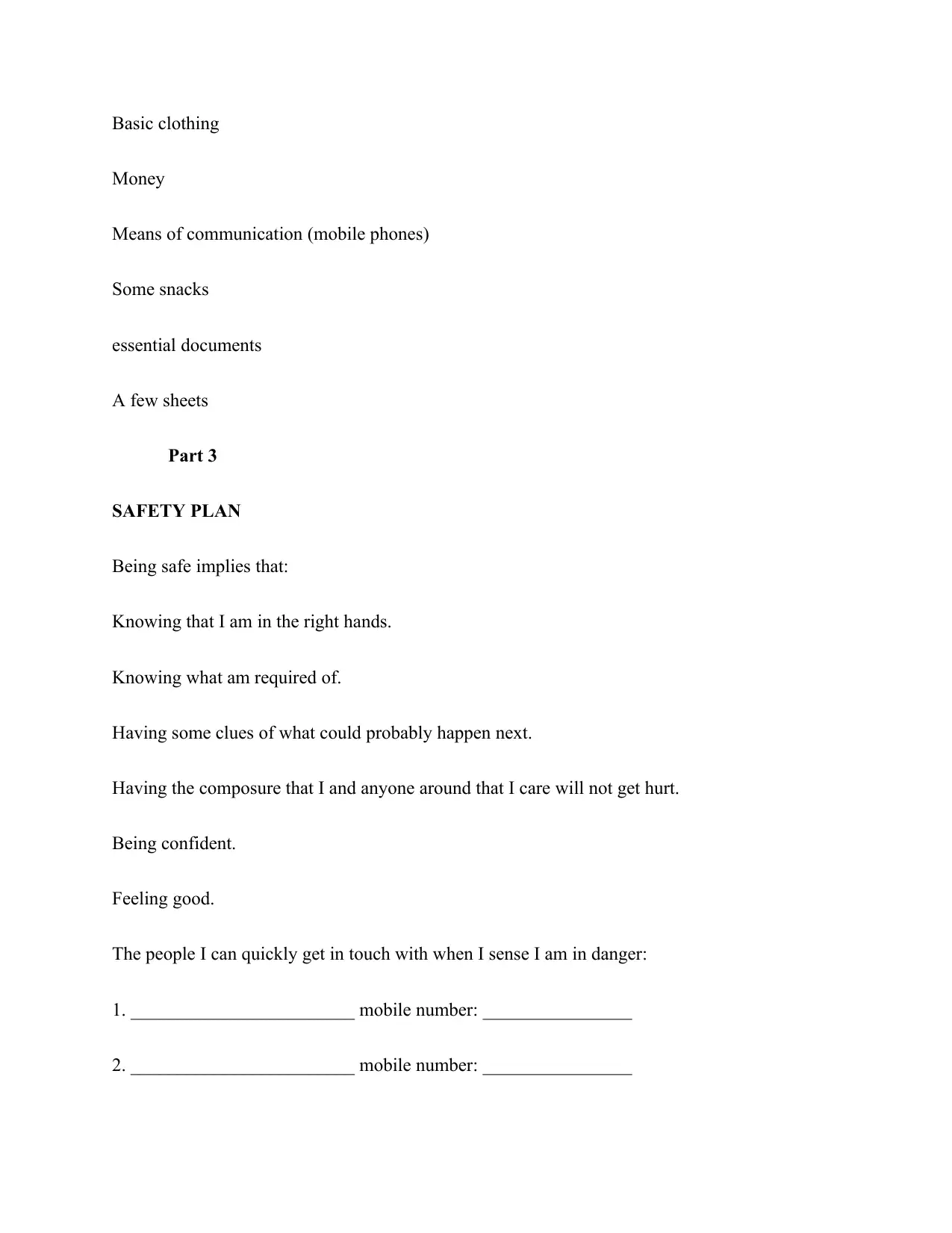
Basic clothing
Money
Means of communication (mobile phones)
Some snacks
essential documents
A few sheets
Part 3
SAFETY PLAN
Being safe implies that:
Knowing that I am in the right hands.
Knowing what am required of.
Having some clues of what could probably happen next.
Having the composure that I and anyone around that I care will not get hurt.
Being confident.
Feeling good.
The people I can quickly get in touch with when I sense I am in danger:
1. ________________________ mobile number: ________________
2. ________________________ mobile number: ________________
Money
Means of communication (mobile phones)
Some snacks
essential documents
A few sheets
Part 3
SAFETY PLAN
Being safe implies that:
Knowing that I am in the right hands.
Knowing what am required of.
Having some clues of what could probably happen next.
Having the composure that I and anyone around that I care will not get hurt.
Being confident.
Feeling good.
The people I can quickly get in touch with when I sense I am in danger:
1. ________________________ mobile number: ________________
2. ________________________ mobile number: ________________
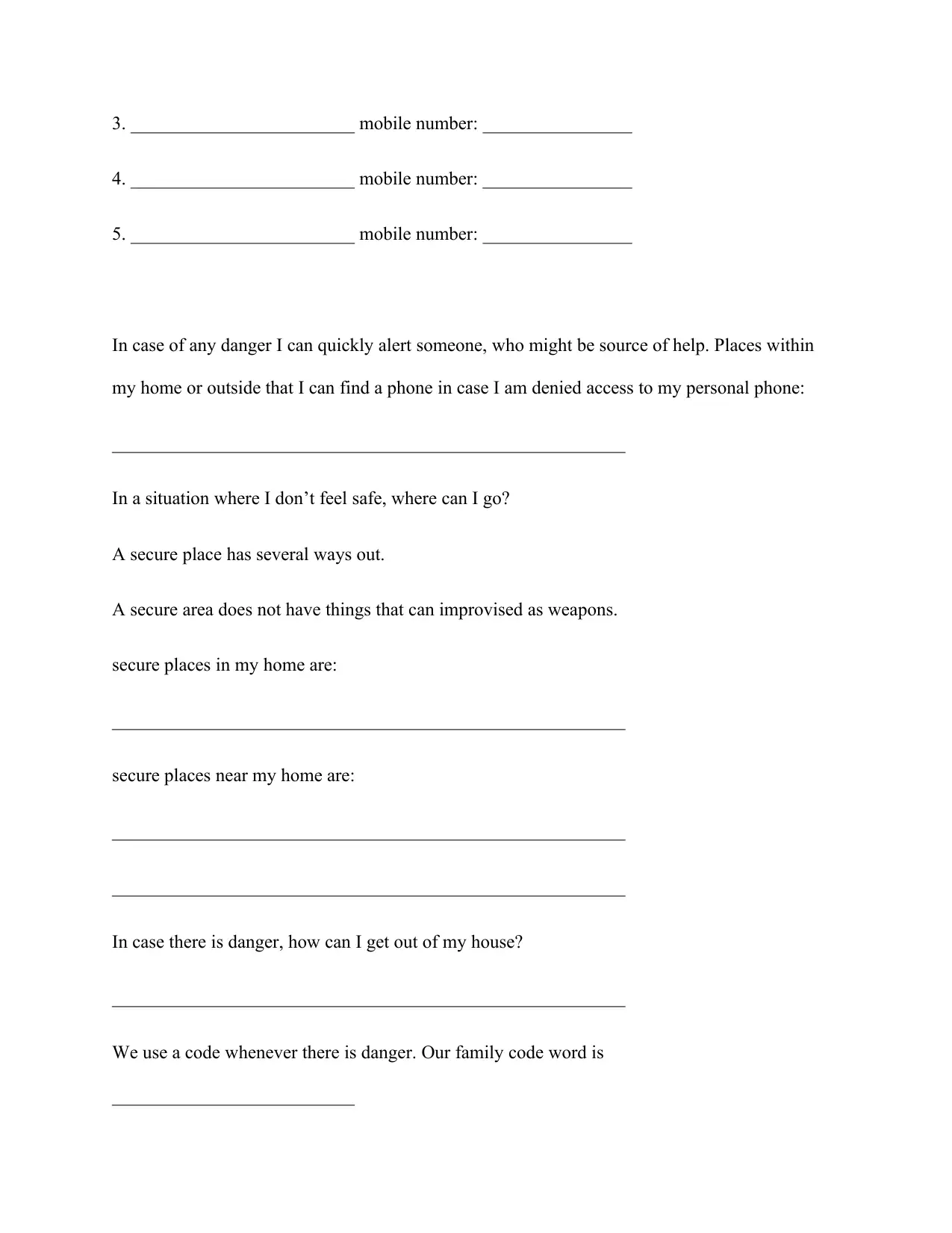
3. ________________________ mobile number: ________________
4. ________________________ mobile number: ________________
5. ________________________ mobile number: ________________
In case of any danger I can quickly alert someone, who might be source of help. Places within
my home or outside that I can find a phone in case I am denied access to my personal phone:
_______________________________________________________
In a situation where I don’t feel safe, where can I go?
A secure place has several ways out.
A secure area does not have things that can improvised as weapons.
secure places in my home are:
_______________________________________________________
secure places near my home are:
_______________________________________________________
_______________________________________________________
In case there is danger, how can I get out of my house?
_______________________________________________________
We use a code whenever there is danger. Our family code word is
__________________________
4. ________________________ mobile number: ________________
5. ________________________ mobile number: ________________
In case of any danger I can quickly alert someone, who might be source of help. Places within
my home or outside that I can find a phone in case I am denied access to my personal phone:
_______________________________________________________
In a situation where I don’t feel safe, where can I go?
A secure place has several ways out.
A secure area does not have things that can improvised as weapons.
secure places in my home are:
_______________________________________________________
secure places near my home are:
_______________________________________________________
_______________________________________________________
In case there is danger, how can I get out of my house?
_______________________________________________________
We use a code whenever there is danger. Our family code word is
__________________________
Paraphrase This Document
Need a fresh take? Get an instant paraphrase of this document with our AI Paraphraser

In case there are children in time of danger, will I be responsible to help them?
____ Yes ____ No
If yes, what will I do?
In case of any danger, will my children be responsible for helping me? ____ Yes ____ No
If yes, what should I do?
_______________________________________________________
_______________________________________________________
NEVER should try to stop a fight because ____________________
_______________________________________________________
Whenever I sense I would get hurt, I should call 999.
When I call 999, I will:
Describe what is going on.
____ Yes ____ No
If yes, what will I do?
In case of any danger, will my children be responsible for helping me? ____ Yes ____ No
If yes, what should I do?
_______________________________________________________
_______________________________________________________
NEVER should try to stop a fight because ____________________
_______________________________________________________
Whenever I sense I would get hurt, I should call 999.
When I call 999, I will:
Describe what is going on.

Tell my address. _________________________
_____________________________________________________
Tell my phone number. My mobile number is ______________
Stay on the phone to answer questions.
I know how to call 000.
Here are some mechanisms that we have always used to stay safe:
1. ____________________________________________________
____________________________________________________
2. ____________________________________________________
____________________________________________________
3. ____________________________________________________
____________________________________________________
If we happen to live home quickly with my children, here are the things I should carry along:
1. ___________________________________________________
2. ___________________________________________________
1. ___________________________________________________
_____________________________________________________
Tell my phone number. My mobile number is ______________
Stay on the phone to answer questions.
I know how to call 000.
Here are some mechanisms that we have always used to stay safe:
1. ____________________________________________________
____________________________________________________
2. ____________________________________________________
____________________________________________________
3. ____________________________________________________
____________________________________________________
If we happen to live home quickly with my children, here are the things I should carry along:
1. ___________________________________________________
2. ___________________________________________________
1. ___________________________________________________
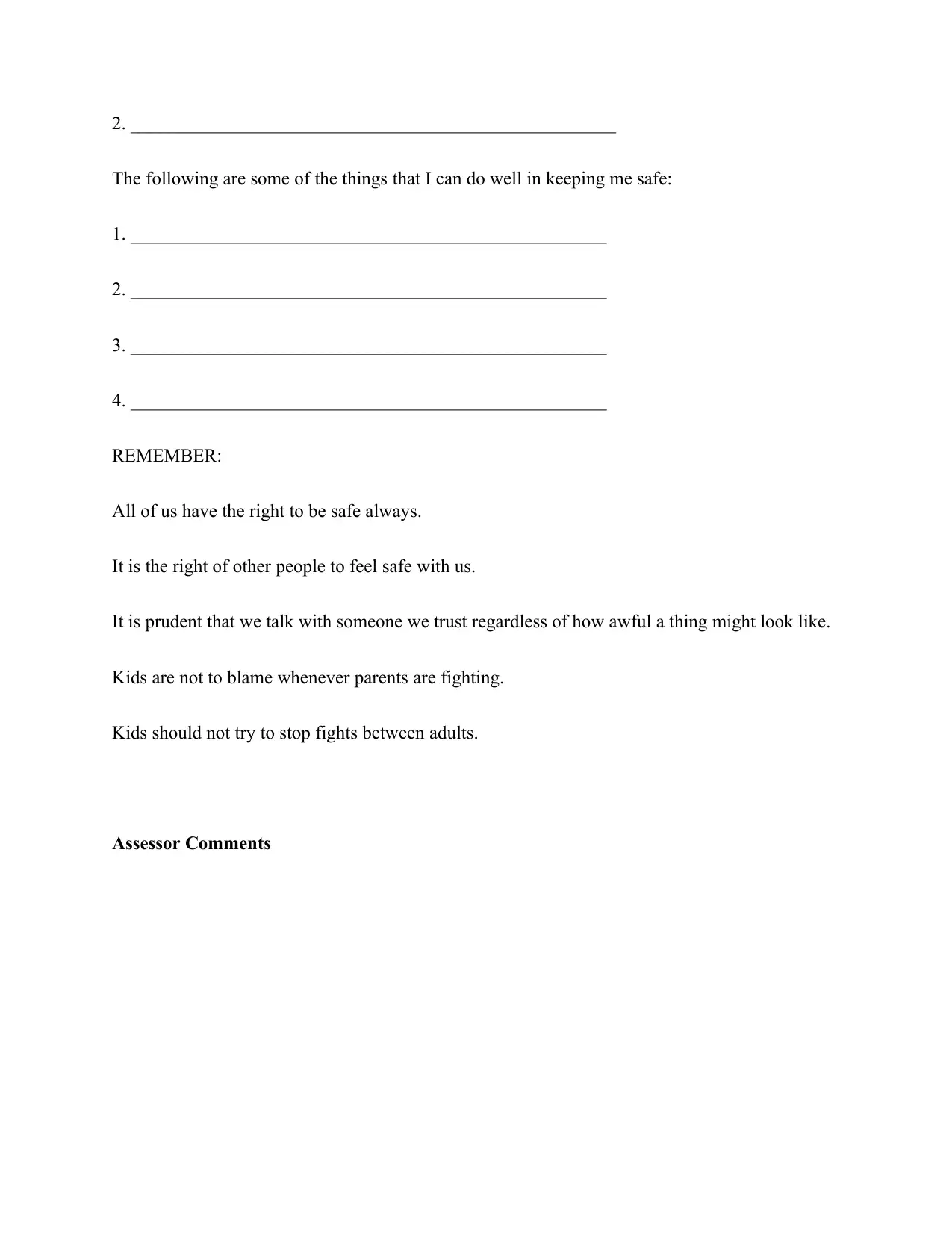
2. ____________________________________________________
The following are some of the things that I can do well in keeping me safe:
1. ___________________________________________________
2. ___________________________________________________
3. ___________________________________________________
4. ___________________________________________________
REMEMBER:
All of us have the right to be safe always.
It is the right of other people to feel safe with us.
It is prudent that we talk with someone we trust regardless of how awful a thing might look like.
Kids are not to blame whenever parents are fighting.
Kids should not try to stop fights between adults.
Assessor Comments
The following are some of the things that I can do well in keeping me safe:
1. ___________________________________________________
2. ___________________________________________________
3. ___________________________________________________
4. ___________________________________________________
REMEMBER:
All of us have the right to be safe always.
It is the right of other people to feel safe with us.
It is prudent that we talk with someone we trust regardless of how awful a thing might look like.
Kids are not to blame whenever parents are fighting.
Kids should not try to stop fights between adults.
Assessor Comments
Secure Best Marks with AI Grader
Need help grading? Try our AI Grader for instant feedback on your assignments.

Satisfactory Not Yet Satisfactory
Assessor Name Date
Activity 5
Name of the client:
Date of birth:
Done by:
Date:
Assessor Name Date
Activity 5
Name of the client:
Date of birth:
Done by:
Date:

Violence directed to the client
Indicator of risk yes, no any other
Has your partner ben
this way for long?
Has it ever occurred
to you that you were
wished you left the
partner?
Do you feel
comfortable staying
around your partner
Do you feel it is an
obligation for you to
stay around or is it
because you have no
other option?
Have you been
experiencing threats
regardless of the type
of the threat?
Have you ever been
threatened to be
Indicator of risk yes, no any other
Has your partner ben
this way for long?
Has it ever occurred
to you that you were
wished you left the
partner?
Do you feel
comfortable staying
around your partner
Do you feel it is an
obligation for you to
stay around or is it
because you have no
other option?
Have you been
experiencing threats
regardless of the type
of the threat?
Have you ever been
threatened to be

killed by your partner
Has it ever occurred
that your partner was
in another
relationship before?
If yes, do you have
any clue on what
caused him to
separate from his
former partner?
Does your partner
have control over you
and everything in the
household?
DVSAT 2
Name of the client:
Date of birth:
Done by:
Date:
Has it ever occurred
that your partner was
in another
relationship before?
If yes, do you have
any clue on what
caused him to
separate from his
former partner?
Does your partner
have control over you
and everything in the
household?
DVSAT 2
Name of the client:
Date of birth:
Done by:
Date:
Paraphrase This Document
Need a fresh take? Get an instant paraphrase of this document with our AI Paraphraser

Violence directed to the client
Indicator of risk Yes, No any other
Who is the bread
winner? You or your
partner?
How old are your
children?
Are your children cat
risk of being affected
by the daily wrangles
that you have
Have you ever
infirmed the
authorities
concerning the
situation at home i.e.
the police or chief?
Are there any
additional factors that
you think are the part
of contribution to
your partners
behavior?
Indicator of risk Yes, No any other
Who is the bread
winner? You or your
partner?
How old are your
children?
Are your children cat
risk of being affected
by the daily wrangles
that you have
Have you ever
infirmed the
authorities
concerning the
situation at home i.e.
the police or chief?
Are there any
additional factors that
you think are the part
of contribution to
your partners
behavior?

In one word, what
can you describe your
partner?
Have you ever been
sexually assaulted?
In your perception,
do you think it is
because of substance
use or mental illness
that your partner
behaves that way.
If none of the above
what could you
possibly guess is the
problem
Activity 6
Part 1
As a service provider I will remain calm and beef up the security within the DFV so that I
don’t just take anything lightly even when I perceive it is dead threat. Beefing up the security
can you describe your
partner?
Have you ever been
sexually assaulted?
In your perception,
do you think it is
because of substance
use or mental illness
that your partner
behaves that way.
If none of the above
what could you
possibly guess is the
problem
Activity 6
Part 1
As a service provider I will remain calm and beef up the security within the DFV so that I
don’t just take anything lightly even when I perceive it is dead threat. Beefing up the security
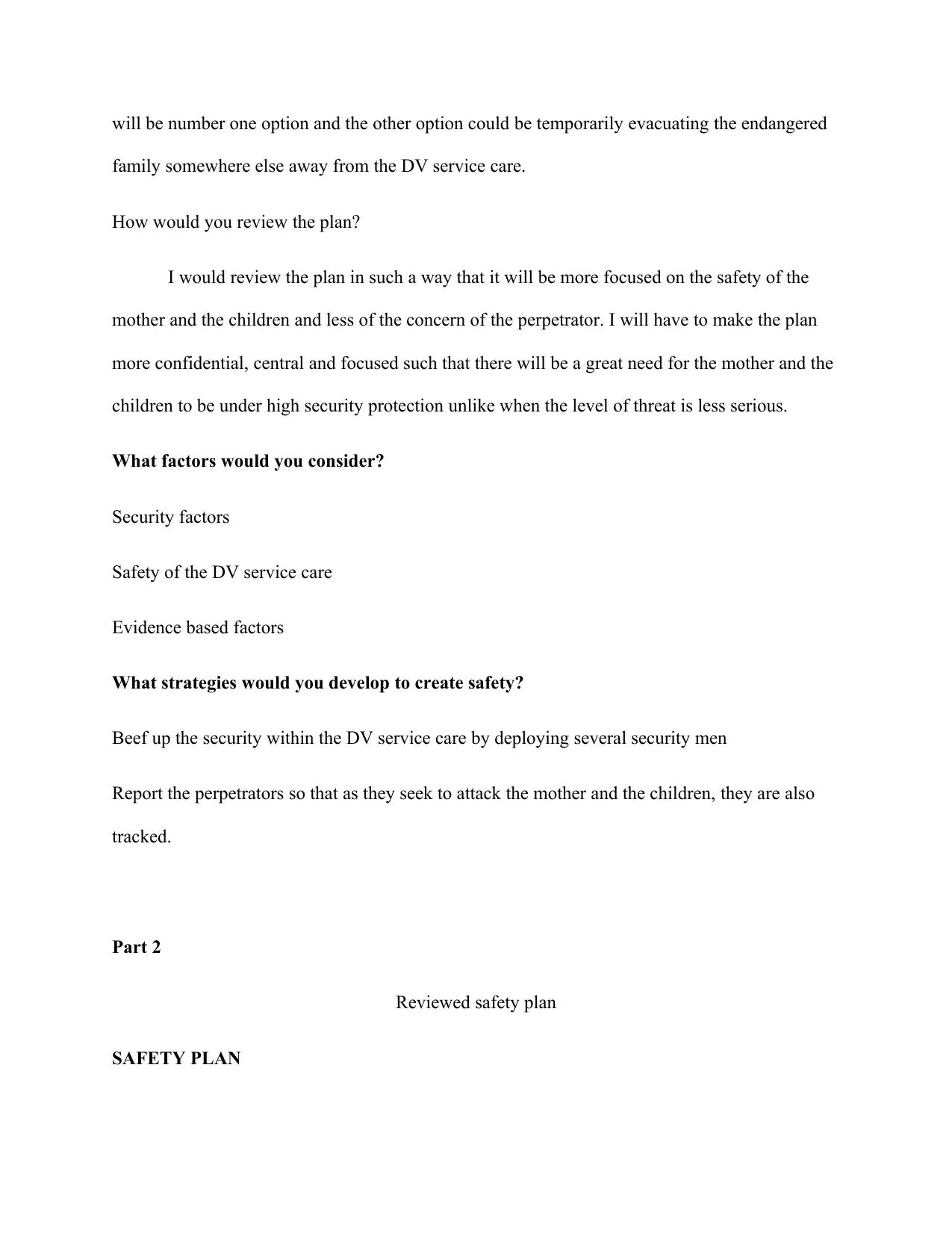
will be number one option and the other option could be temporarily evacuating the endangered
family somewhere else away from the DV service care.
How would you review the plan?
I would review the plan in such a way that it will be more focused on the safety of the
mother and the children and less of the concern of the perpetrator. I will have to make the plan
more confidential, central and focused such that there will be a great need for the mother and the
children to be under high security protection unlike when the level of threat is less serious.
What factors would you consider?
Security factors
Safety of the DV service care
Evidence based factors
What strategies would you develop to create safety?
Beef up the security within the DV service care by deploying several security men
Report the perpetrators so that as they seek to attack the mother and the children, they are also
tracked.
Part 2
Reviewed safety plan
SAFETY PLAN
family somewhere else away from the DV service care.
How would you review the plan?
I would review the plan in such a way that it will be more focused on the safety of the
mother and the children and less of the concern of the perpetrator. I will have to make the plan
more confidential, central and focused such that there will be a great need for the mother and the
children to be under high security protection unlike when the level of threat is less serious.
What factors would you consider?
Security factors
Safety of the DV service care
Evidence based factors
What strategies would you develop to create safety?
Beef up the security within the DV service care by deploying several security men
Report the perpetrators so that as they seek to attack the mother and the children, they are also
tracked.
Part 2
Reviewed safety plan
SAFETY PLAN
Secure Best Marks with AI Grader
Need help grading? Try our AI Grader for instant feedback on your assignments.
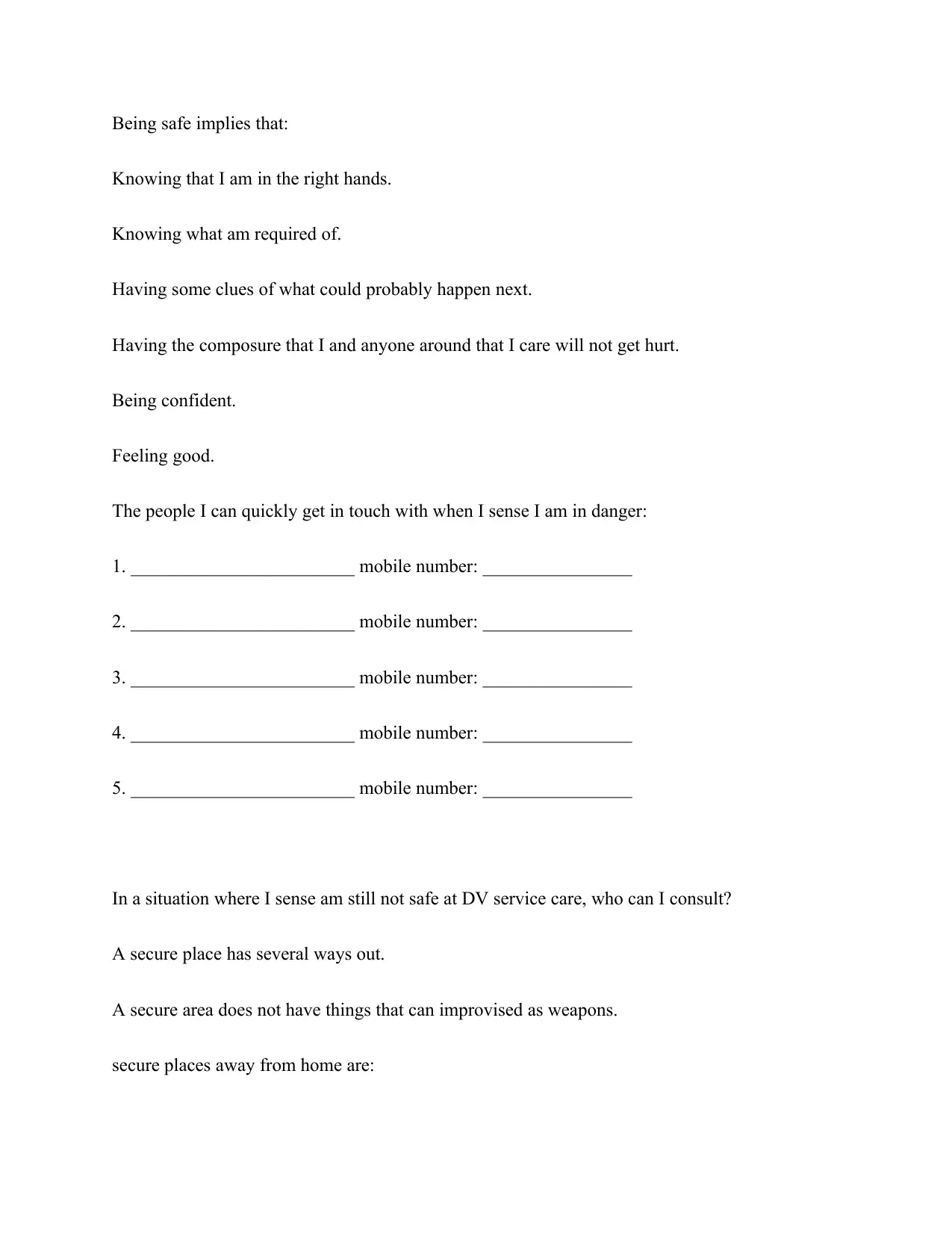
Being safe implies that:
Knowing that I am in the right hands.
Knowing what am required of.
Having some clues of what could probably happen next.
Having the composure that I and anyone around that I care will not get hurt.
Being confident.
Feeling good.
The people I can quickly get in touch with when I sense I am in danger:
1. ________________________ mobile number: ________________
2. ________________________ mobile number: ________________
3. ________________________ mobile number: ________________
4. ________________________ mobile number: ________________
5. ________________________ mobile number: ________________
In a situation where I sense am still not safe at DV service care, who can I consult?
A secure place has several ways out.
A secure area does not have things that can improvised as weapons.
secure places away from home are:
Knowing that I am in the right hands.
Knowing what am required of.
Having some clues of what could probably happen next.
Having the composure that I and anyone around that I care will not get hurt.
Being confident.
Feeling good.
The people I can quickly get in touch with when I sense I am in danger:
1. ________________________ mobile number: ________________
2. ________________________ mobile number: ________________
3. ________________________ mobile number: ________________
4. ________________________ mobile number: ________________
5. ________________________ mobile number: ________________
In a situation where I sense am still not safe at DV service care, who can I consult?
A secure place has several ways out.
A secure area does not have things that can improvised as weapons.
secure places away from home are:
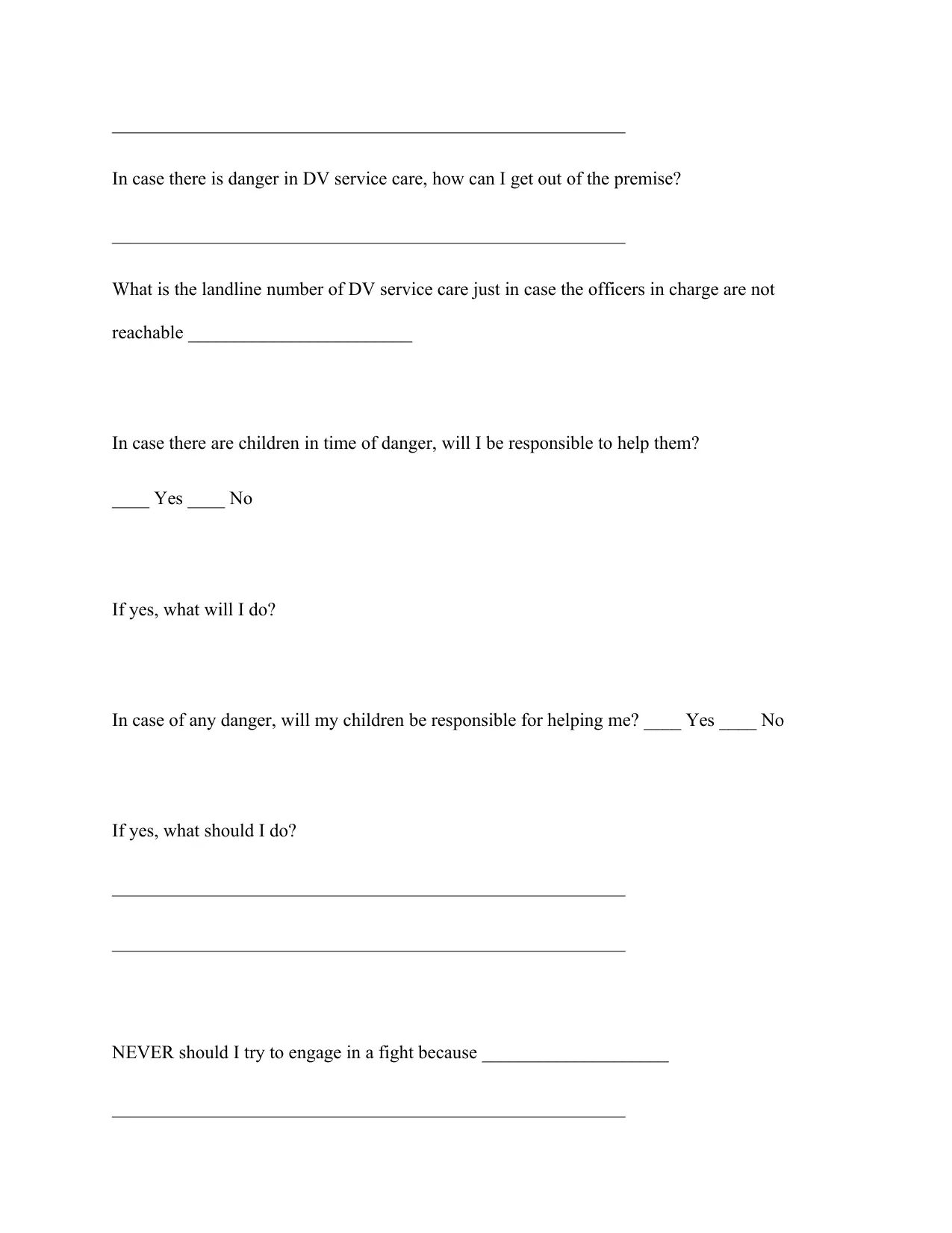
_______________________________________________________
In case there is danger in DV service care, how can I get out of the premise?
_______________________________________________________
What is the landline number of DV service care just in case the officers in charge are not
reachable ________________________
In case there are children in time of danger, will I be responsible to help them?
____ Yes ____ No
If yes, what will I do?
In case of any danger, will my children be responsible for helping me? ____ Yes ____ No
If yes, what should I do?
_______________________________________________________
_______________________________________________________
NEVER should I try to engage in a fight because ____________________
_______________________________________________________
In case there is danger in DV service care, how can I get out of the premise?
_______________________________________________________
What is the landline number of DV service care just in case the officers in charge are not
reachable ________________________
In case there are children in time of danger, will I be responsible to help them?
____ Yes ____ No
If yes, what will I do?
In case of any danger, will my children be responsible for helping me? ____ Yes ____ No
If yes, what should I do?
_______________________________________________________
_______________________________________________________
NEVER should I try to engage in a fight because ____________________
_______________________________________________________

Whenever I sense I would get hurt, I should call 999.
When I call 999, I will:
Describe what is going on.
Tell my address. _________________________
_____________________________________________________
Tell my phone number. My mobile number is ______________
Stay on the phone to answer questions.
I know how to call 999.
Here are some mechanisms I can use to stay safe without the help of anyone:
1. ____________________________________________________
____________________________________________________
2. ____________________________________________________
____________________________________________________
3. ____________________________________________________
____________________________________________________
When I call 999, I will:
Describe what is going on.
Tell my address. _________________________
_____________________________________________________
Tell my phone number. My mobile number is ______________
Stay on the phone to answer questions.
I know how to call 999.
Here are some mechanisms I can use to stay safe without the help of anyone:
1. ____________________________________________________
____________________________________________________
2. ____________________________________________________
____________________________________________________
3. ____________________________________________________
____________________________________________________
Paraphrase This Document
Need a fresh take? Get an instant paraphrase of this document with our AI Paraphraser
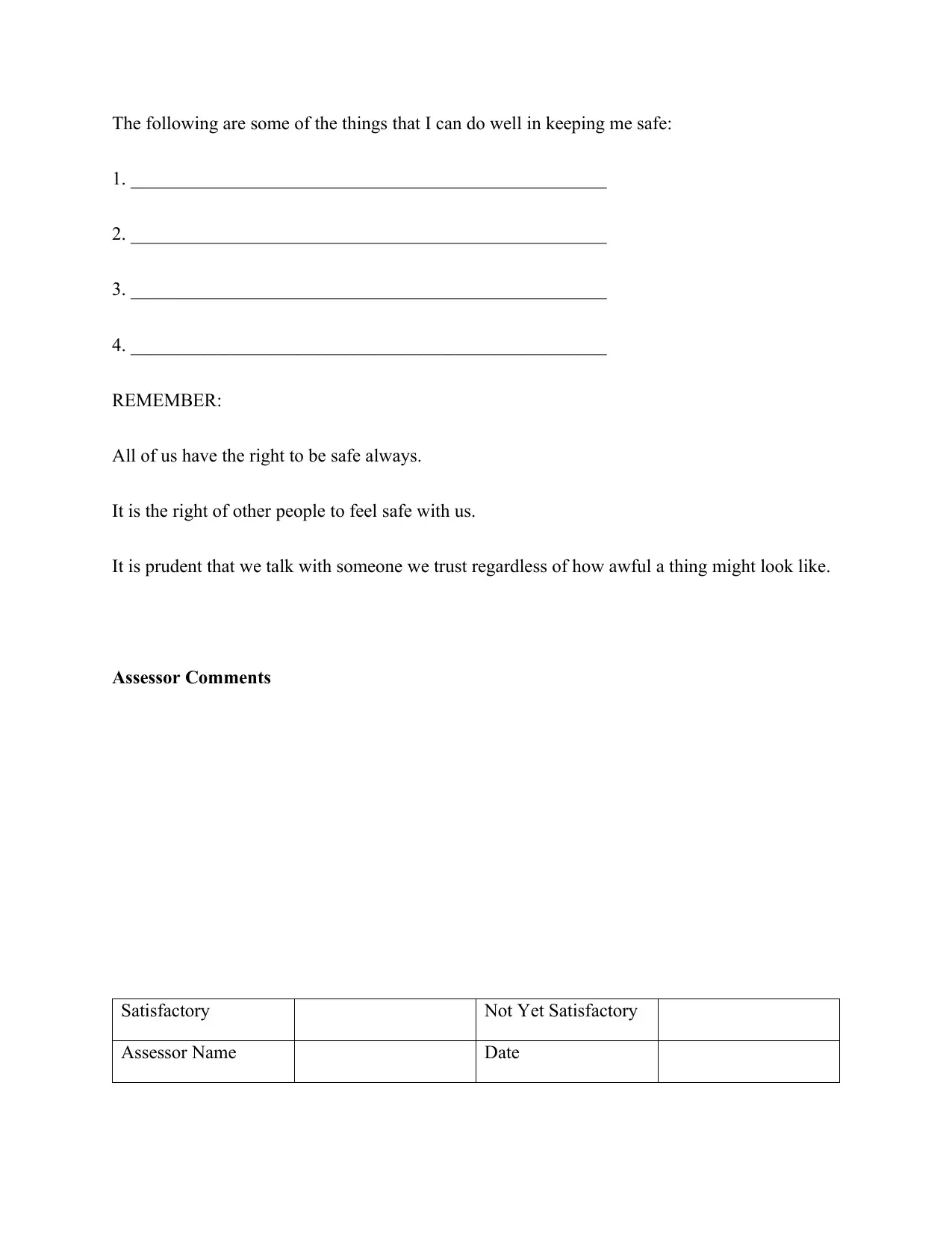
The following are some of the things that I can do well in keeping me safe:
1. ___________________________________________________
2. ___________________________________________________
3. ___________________________________________________
4. ___________________________________________________
REMEMBER:
All of us have the right to be safe always.
It is the right of other people to feel safe with us.
It is prudent that we talk with someone we trust regardless of how awful a thing might look like.
Assessor Comments
Satisfactory Not Yet Satisfactory
Assessor Name Date
1. ___________________________________________________
2. ___________________________________________________
3. ___________________________________________________
4. ___________________________________________________
REMEMBER:
All of us have the right to be safe always.
It is the right of other people to feel safe with us.
It is prudent that we talk with someone we trust regardless of how awful a thing might look like.
Assessor Comments
Satisfactory Not Yet Satisfactory
Assessor Name Date

References
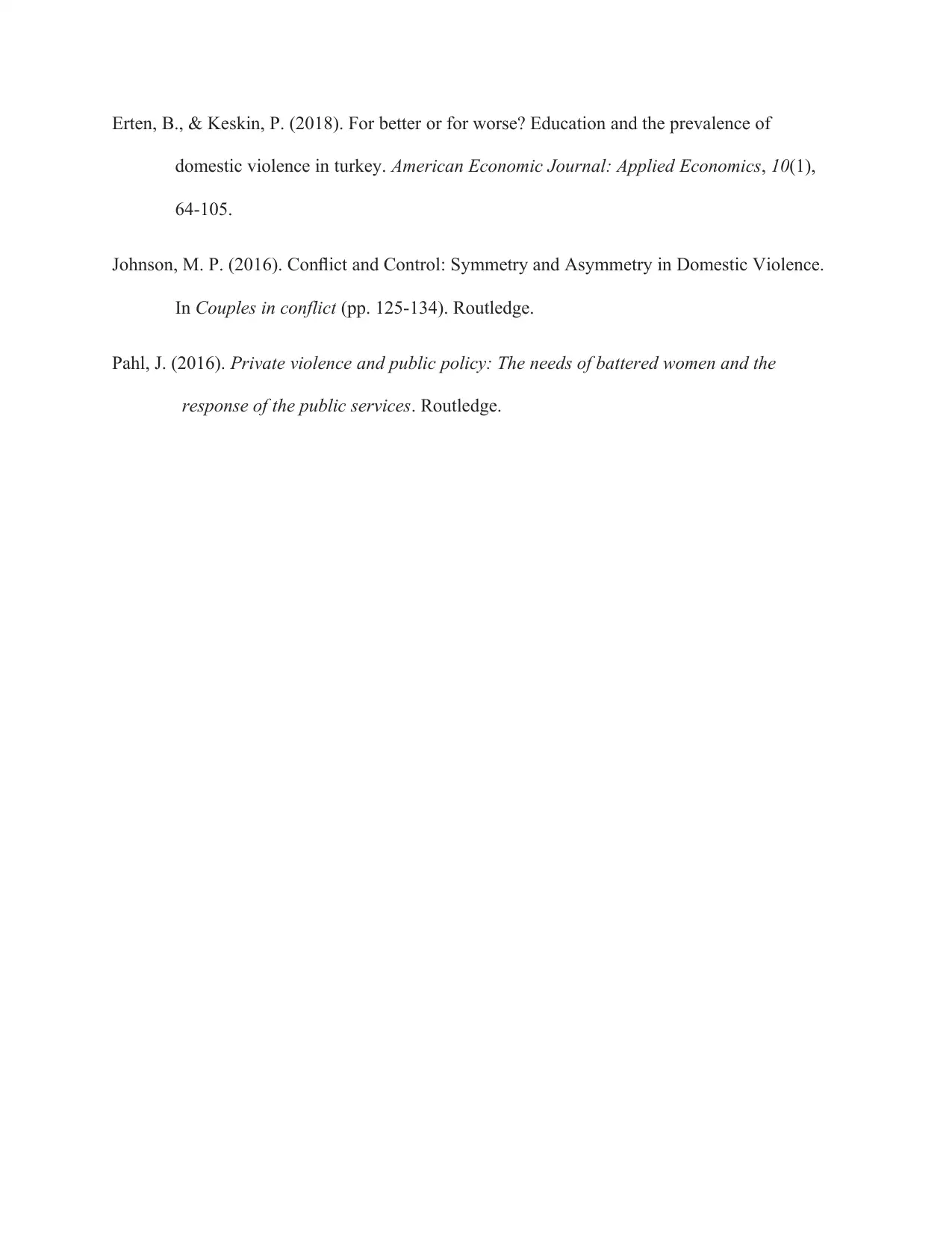
Erten, B., & Keskin, P. (2018). For better or for worse? Education and the prevalence of
domestic violence in turkey. American Economic Journal: Applied Economics, 10(1),
64-105.
Johnson, M. P. (2016). Conflict and Control: Symmetry and Asymmetry in Domestic Violence.
In Couples in conflict (pp. 125-134). Routledge.
Pahl, J. (2016). Private violence and public policy: The needs of battered women and the
response of the public services. Routledge.
domestic violence in turkey. American Economic Journal: Applied Economics, 10(1),
64-105.
Johnson, M. P. (2016). Conflict and Control: Symmetry and Asymmetry in Domestic Violence.
In Couples in conflict (pp. 125-134). Routledge.
Pahl, J. (2016). Private violence and public policy: The needs of battered women and the
response of the public services. Routledge.
1 out of 22
Related Documents
Your All-in-One AI-Powered Toolkit for Academic Success.
+13062052269
info@desklib.com
Available 24*7 on WhatsApp / Email
![[object Object]](/_next/static/media/star-bottom.7253800d.svg)
Unlock your academic potential
© 2024 | Zucol Services PVT LTD | All rights reserved.




